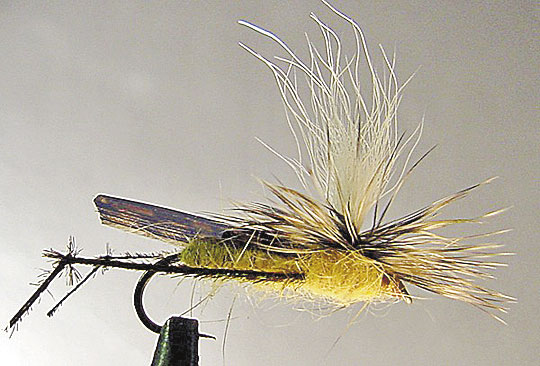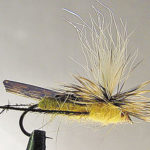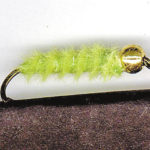
I discovered on a late summer outing to Tanasee Creek in Jackson County that brown trout are especially fond of inchworms.I had been fishing for two hours, working some beautiful stretches of water with a variety of dry flies and nymphs, and I hadn’t raised a single trout.
Since nothing else was working, I tied on a beadhead inchworm. My initial cast was way off target, and just as I was getting ready to lift the fly out of the water to make another cast, a big brown darted out of the shadows, surprising me so completely I missed the strike.
After that, I caught a brown on just about every cast. The fly became so ragged it barely had any green dubbing left. Unfortunately, it was the only inchworm in my fly box. Now, I make certain I have plenty of inchworms and other terrestrials when I fish in the late summer and early fall. I also find that I miss far fewer fish when I use terrestrials. Trout just don’t want to let a big bug get away.
Inchworms are excellent patterns because they work just about any place in a stream from pools to riffles. Beadhead patterns work better than non-weighted patterns because the fly tumbles more like a real inchworm, and the added weight gets the fly down into deeper water, an important factor when fishing in hot weather.
Terrestrials usually begin turning up in late May and June, and these insects — ants, beetles, grasshoppers, inchworms, crickets, bees, caterpillars — fall or get blown into streams and become a major part of a trout’s diet until the first freeze in late fall either kills them off or sends them scurrying underground to await another season.
While light presentation is paramount in “match-the-hatch” dry-fly fishing, this isn’t the case when fishing with terrestrials. A terrestrial should land in the water with a plop, a natural sound that immediately gets a trout’s attention.
Since terrestrials usually are found in trees, bushes, and grass along edges of streams, cast close to banks because trout know these insects are more likely to fall or land in the water near shorelines.
Good grasshopper and cricket patterns are the Letort hopper and Letort cricket, tied with horsehair. Yellow, brown or black Humpy patterns are good beetle imitations because of the bulbous body.
Black ants tied either with foam or dubbing are good for late August and early September. If you see trout feeding under tree overhangs and there’s no wind, the trout usually are feeding on beetles. If the wind is blowing, an ant pattern is recommended because ants are more likely to be blown into the water than beetles. Insects don’t just jump in the water; they either land there accidentally or they are blown in.
Carpenter ants are the most common ants found along stream banks. This fly is easy to tie. Use two black balls of dubbing separated by a midsection that has a few strands of peacock or pearl-colored Krystal Flash and a few turns of CDC fiber. The Krystal Flash draws attention to the ant, and the CDC fibers wave like the legs of a struggling ant
Preferred fishing technique for ants and hoppers is to let the fly ride on the surface and give it an occasional twitch to make it appear more like a live insect struggling in the water.
Another good terrestrial to use in late summer, particularly in September and October, is a caterpillar pattern. Caterpillars are plentiful this time of the year, and they’re always falling into the water.
Size should be as close to the real insect as possible. For ants, use Nos. 12 or 14. For beetles, inchworms, caterpillars, bees, a No. 10 is recommended. Hoppers can be Nos. 8 or 10.
Unlike spring hatches, terrestrials come in all shapes and sizes, and trout don’t see them in great numbers since they randomly fall or land in the water. What a trout does see is a big mouthful of protein, and it will go out of its way to grab it.
Most terrestrials are easy to tie, especially ant and inchworm patterns, and you don’t have to be particular about getting an exact imitation.
On summer days when everyone is complaining about fish not hitting, load up with terrestrials and head for a remote mountain stream. You’re almost guaranteed to catch trout.
• • • • •
Sections of three streams and one lake are proposed for inclusion in the Delayed Harvest Trout Waters Program for the 2011-2012 season. The streams are 1.7 miles of Spring Creek in Madison County, two miles of the Ararat River in Surry County, and one mile of Elk Creek in Wilkes County. Coffee Lake in Watauga County would be reclassified from hatchery supported to delayed-harvest waters.
The N.C. Wildlife Resources Commission will present these and other proposals related to hunting and fishing at public hearings scheduled for this month.






Be the first to comment